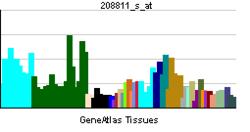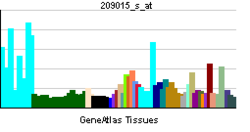- DNAJB6
-
DnaJ homolog subfamily B member 6 is a protein that in humans is encoded by the DNAJB6 gene.[1][2][3]
This gene encodes a member of the DNAJ protein family. DNAJ family members are characterized by a highly conserved amino acid stretch called the 'J-domain' and function as one of the two major classes of molecular chaperones involved in a wide range of cellular events, such as protein folding and oligomeric protein complex assembly. This family member may also play a role in polyglutamine aggregation in specific neurons. Alternative splicing of this gene results in multiple transcript variants; however, not all variants have been fully described.[3]
Interactions
DNAJB6 has been shown to interact with Keratin 18.[4]
References
- ^ Seki N, Hattori A, Hayashi A, Kozuma S, Miyajima N, Saito T (Jun 1999). "Cloning, tissue expression, and chromosomal assignment of human MRJ gene for a member of the DNAJ protein family". J Hum Genet 44 (3): 185–9. doi:10.1007/s100380050139. PMID 10319584.
- ^ Pei L (Mar 1999). "Pituitary tumor-transforming gene protein associates with ribosomal protein S10 and a novel human homologue of DnaJ in testicular cells". J Biol Chem 274 (5): 3151–8. doi:10.1074/jbc.274.5.3151. PMID 9915854.
- ^ a b "Entrez Gene: DNAJB6 DnaJ (Hsp40) homolog, subfamily B, member 6". http://www.ncbi.nlm.nih.gov/sites/entrez?Db=gene&Cmd=ShowDetailView&TermToSearch=10049.
- ^ Izawa, I; Nishizawa M, Ohtakara K, Ohtsuka K, Inada H, Inagaki M (Nov. 2000). "Identification of Mrj, a DnaJ/Hsp40 family protein, as a keratin 8/18 filament regulatory protein". J. Biol. Chem. (UNITED STATES) 275 (44): 34521–7. doi:10.1074/jbc.M003492200. ISSN 0021-9258. PMID 10954706.
Further reading
- Maruyama K, Sugano S (1994). "Oligo-capping: a simple method to replace the cap structure of eukaryotic mRNAs with oligoribonucleotides". Gene 138 (1–2): 171–4. doi:10.1016/0378-1119(94)90802-8. PMID 8125298.
- Suzuki Y, Yoshitomo-Nakagawa K, Maruyama K et al. (1997). "Construction and characterization of a full length-enriched and a 5'-end-enriched cDNA library". Gene 200 (1–2): 149–56. doi:10.1016/S0378-1119(97)00411-3. PMID 9373149.
- Izawa I, Nishizawa M, Ohtakara K et al. (2000). "Identification of Mrj, a DnaJ/Hsp40 family protein, as a keratin 8/18 filament regulatory protein". J. Biol. Chem. 275 (44): 34521–7. doi:10.1074/jbc.M003492200. PMID 10954706.
- Hartley JL, Temple GF, Brasch MA (2001). "DNA Cloning Using In Vitro Site-Specific Recombination". Genome Res. 10 (11): 1788–95. doi:10.1101/gr.143000. PMC 310948. PMID 11076863. http://www.pubmedcentral.nih.gov/articlerender.fcgi?tool=pmcentrez&artid=310948.
- Ohtsuka K, Hata M (2001). "Mammalian HSP40/DNAJ homologs: cloning of novel cDNAs and a proposal for their classification and nomenclature". Cell Stress Chaperones 5 (2): 98–112. doi:10.1379/1466-1268(2000)005<0098:MHDHCO>2.0.CO;2. ISSN 1466-1268. PMC 312896. PMID 11147971. http://www.pubmedcentral.nih.gov/articlerender.fcgi?tool=pmcentrez&artid=312896.
- Wiemann S, Weil B, Wellenreuther R et al. (2001). "Toward a Catalog of Human Genes and Proteins: Sequencing and Analysis of 500 Novel Complete Protein Coding Human cDNAs". Genome Res. 11 (3): 422–35. doi:10.1101/gr.GR1547R. PMC 311072. PMID 11230166. http://www.pubmedcentral.nih.gov/articlerender.fcgi?tool=pmcentrez&artid=311072.
- Chuang JZ, Zhou H, Zhu M et al. (2002). "Characterization of a brain-enriched chaperone, MRJ, that inhibits Huntingtin aggregation and toxicity independently". J. Biol. Chem. 277 (22): 19831–8. doi:10.1074/jbc.M109613200. PMID 11896048.
- Farinha CM, Nogueira P, Mendes F et al. (2002). "The human DnaJ homologue (Hdj)-1/heat-shock protein (Hsp) 40 co-chaperone is required for the in vivo stabilization of the cystic fibrosis transmembrane conductance regulator by Hsp70". Biochem. J. 366 (Pt 3): 797–806. doi:10.1042/BJ20011717. PMC 1222832. PMID 12069690. http://www.pubmedcentral.nih.gov/articlerender.fcgi?tool=pmcentrez&artid=1222832.
- Strausberg RL, Feingold EA, Grouse LH et al. (2003). "Generation and initial analysis of more than 15,000 full-length human and mouse cDNA sequences". Proc. Natl. Acad. Sci. U.S.A. 99 (26): 16899–903. doi:10.1073/pnas.242603899. PMC 139241. PMID 12477932. http://www.pubmedcentral.nih.gov/articlerender.fcgi?tool=pmcentrez&artid=139241.
- Scherer SW, Cheung J, MacDonald JR et al. (2003). "Human Chromosome 7: DNA Sequence and Biology". Science 300 (5620): 767–72. doi:10.1126/science.1083423. PMC 2882961. PMID 12690205. http://www.pubmedcentral.nih.gov/articlerender.fcgi?tool=pmcentrez&artid=2882961.
- Hillier LW, Fulton RS, Fulton LA et al. (2003). "The DNA sequence of human chromosome 7". Nature 424 (6945): 157–64. doi:10.1038/nature01782. PMID 12853948.
- Hanai R, Mashima K (2004). "Characterization of two isoforms of a human DnaJ homologue, HSJ2". Mol. Biol. Rep. 30 (3): 149–53. doi:10.1023/A:1024916223616. PMID 12974469.
- Ota T, Suzuki Y, Nishikawa T et al. (2004). "Complete sequencing and characterization of 21,243 full-length human cDNAs". Nat. Genet. 36 (1): 40–5. doi:10.1038/ng1285. PMID 14702039.
- Liu Y, Zhu MC, Wang YJ et al. (2004). "[Cloning of a DnaJ homolog chaperon PBP and its subcellular localization]". Xi Bao Yu Fen Zi Mian Yi Xue Za Zhi 19 (6): 531–4. PMID 15182641.
- Berruti G, Martegani E (2005). "The deubiquitinating enzyme mUBPy interacts with the sperm-specific molecular chaperone MSJ-1: the relation with the proteasome, acrosome, and centrosome in mouse male germ cells". Biol. Reprod. 72 (1): 14–21. doi:10.1095/biolreprod.104.030866. PMID 15342353.
- Gerhard DS, Wagner L, Feingold EA et al. (2004). "The Status, Quality, and Expansion of the NIH Full-Length cDNA Project: The Mammalian Gene Collection (MGC)". Genome Res. 14 (10B): 2121–7. doi:10.1101/gr.2596504. PMC 528928. PMID 15489334. http://www.pubmedcentral.nih.gov/articlerender.fcgi?tool=pmcentrez&artid=528928.
- Wiemann S, Arlt D, Huber W et al. (2004). "From ORFeome to Biology: A Functional Genomics Pipeline". Genome Res. 14 (10B): 2136–44. doi:10.1101/gr.2576704. PMC 528930. PMID 15489336. http://www.pubmedcentral.nih.gov/articlerender.fcgi?tool=pmcentrez&artid=528930.
- Rual JF, Venkatesan K, Hao T et al. (2005). "Towards a proteome-scale map of the human protein-protein interaction network". Nature 437 (7062): 1173–8. doi:10.1038/nature04209. PMID 16189514.
- Dai YS, Xu J, Molkentin JD (2005). "The DnaJ-Related Factor Mrj Interacts with Nuclear Factor of Activated T Cells c3 and Mediates Transcriptional Repression through Class II Histone Deacetylase Recruitment". Mol. Cell. Biol. 25 (22): 9936–48. doi:10.1128/MCB.25.22.9936-9948.2005. PMC 1280278. PMID 16260608. http://www.pubmedcentral.nih.gov/articlerender.fcgi?tool=pmcentrez&artid=1280278.
Chaperones/
protein foldingOtherProtein targeting Ubiquitin E1 Ubiquitin-activating enzyme (UBA1, UBA2, UBA3, UBA5, UBA6, UBA7, ATG7, NAE1, SAE1)
E2 Ubiquitin-conjugating enzyme (A • B • C • D1, D2, D3 • E1, E2, E3 • G1, G2 • H • I • J1, J2 • K • L1, L2, L3, L4, L6 • M • N • O • Q1, Q2 • R1 (CDC34), R2 • S • V1, V2 • Z)
E3 Ubiquitin ligase (VHL, Cullin, CBL, MDM2, FANCL, UBR1)
Deubiquitinating enzyme: Ataxin 3 • USP6 • CYLD
ATG3 • BIRC6 • UFC1Other Categories:- Human proteins
- Chromosome 7 gene stubs
- Heat shock proteins
Wikimedia Foundation. 2010.


